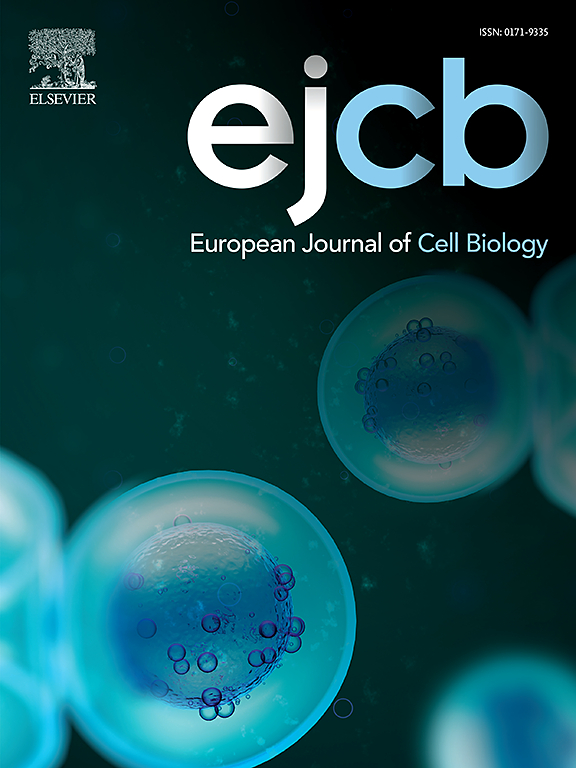Role of the sodium/calcium exchanger type 3 in cancer cells
IF 4.3
3区 生物学
Q2 CELL BIOLOGY
引用次数: 0
Abstract
The sodium/calcium exchanger (NCX) type 1 has been well described in various cancers, but little is known about the other two NCX types (NCX2 and NCX3). In this study, we used the selective blocker of NCX3 – YM-244769 to investigate changes in apoptosis induction, migration, proliferation, intracellular calcium and ATP in four cancer cell lines – DLD1, HeLa, MDA-MB-231 and JIMT1. In all four cell lines we observed a concentration-dependent increase in the number of apoptotic cells, as well as reduced migration and proliferation. Induction of hypoxic conditions did not alter the response of these cells to YM-244769 in any of the above-mentioned parameters. These results indicate the role of NCX3 in cancer cell migration, proliferation and apoptosis, as inhibition of NCX1 by the specific blocker SEA0400 had no significant effect on these parameters. However, we verified the effect of NCX3 inhibition by using CRISPR/Cas9 to generate clones in which the SLC8A3 (NCX3) gene was deleted, and we obtained the same results. In addition, mitochondrial respiration was impaired in the clones with NCX3 knocked-out, suggesting that NCX3 also play a role in bioenergetics. In conclusion, we have clearly shown that NCX3 plays an important anti-apoptotic, pro-migratory and proliferative role in the cancer cells by affecting mitochondrial bioenergetics, thus supporting their survival and fate.
3型钠/钙交换剂在癌细胞中的作用
钠/钙交换器(NCX) 1型已经在各种癌症中得到了很好的描述,但对其他两种NCX类型(NCX2和NCX3)知之甚少。本研究利用NCX3 - YM-244769选择性阻断剂,研究了DLD1、HeLa、MDA-MB-231和JIMT1四种癌细胞的凋亡诱导、迁移、增殖、胞内钙和ATP的变化。在所有四种细胞系中,我们观察到凋亡细胞数量的浓度依赖性增加,以及迁移和增殖的减少。缺氧条件的诱导并没有改变这些细胞对上述任何参数的m -244769的反应。这些结果表明NCX3在癌细胞迁移、增殖和凋亡中的作用,而特异性阻滞剂SEA0400对NCX1的抑制对这些参数没有显著影响。然而,我们利用CRISPR/Cas9构建SLC8A3 (NCX3)基因缺失的克隆,验证了NCX3抑制的效果,得到了相同的结果。此外,NCX3基因敲除的克隆线粒体呼吸功能受损,表明NCX3也在生物能量学中发挥作用。综上所述,我们已经清楚地表明NCX3通过影响线粒体生物能量学在癌细胞中发挥重要的抗凋亡、促迁移和增殖作用,从而支持癌细胞的生存和命运。
本文章由计算机程序翻译,如有差异,请以英文原文为准。
求助全文
约1分钟内获得全文
求助全文
来源期刊

European journal of cell biology
生物-细胞生物学
CiteScore
7.30
自引率
1.50%
发文量
80
审稿时长
38 days
期刊介绍:
The European Journal of Cell Biology, a journal of experimental cell investigation, publishes reviews, original articles and short communications on the structure, function and macromolecular organization of cells and cell components. Contributions focusing on cellular dynamics, motility and differentiation, particularly if related to cellular biochemistry, molecular biology, immunology, neurobiology, and developmental biology are encouraged. Manuscripts describing significant technical advances are also welcome. In addition, papers dealing with biomedical issues of general interest to cell biologists will be published. Contributions addressing cell biological problems in prokaryotes and plants are also welcome.
 求助内容:
求助内容: 应助结果提醒方式:
应助结果提醒方式:


